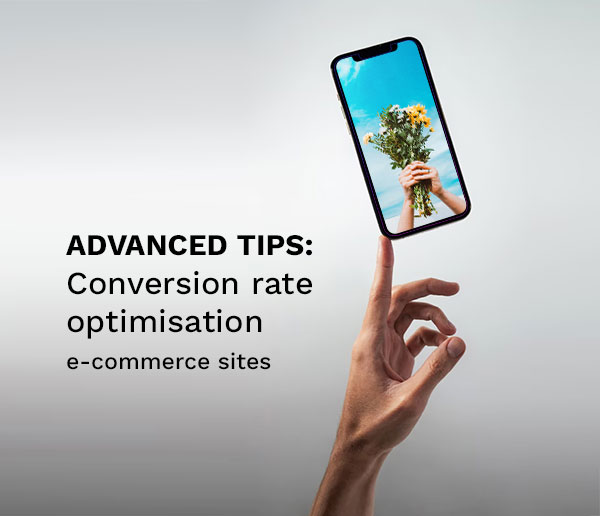
9 advanced tips on increasing your e-commerce website conversion rate
An e-commerce conversion rate is a simple one to understand.
It is based on the number of users who take the desired action (purchases) on your website.
Either people buy from your website, or they don’t. Some become customers, whereas some remain visitors only.
But when you compare the % of visitors who purchase from your website with the total number of visitors who have visited your website, you get the website conversion rate.
And so, we introduce “Conversion Rate Optimisation”
As a result, business owners strive to improve conversion rate optimisation (CRO- increase user actions on the website) to gain better profits.
Conversion rates depend on the industry – for example, it would be 2.44 in arts and crafts and .99% in the baby and child website market. Check out these other stats on e-commerce conversion rates
If you wish to stay above average, and get the maximum out of your marketing efforts, your website needs even more than optimised content and relevant keywords.
To raise conversions from existing traffic requires proper strategies and planning. Below are some best-proven methods that can help you increase conversions.
Tips for increasing ecommerce conversion rate:
Establish your business goals:
In many cases, it has been observed that business owners lack in defining goals for their website. Thus, evaluation of conversion rate becomes a complex process because if the website goals are not defined, how will you improve your website performance or raise the conversion graph line?
Some entrepreneurs make a goal to gain more network traffic. But, that goal is not feasible since your website may have thousands of visitors, but if they don’t purchase your products, it’s useless. So, instead, refine the definition of your goals, focusing on better conversions and profits.
Examples of conversion goals for website:
● Number of purchases
● Count of form submissions
● Number of clicks
● Number of accounts created
● Count of page visits
Once defined, visitor behaviour should be accessed via these goals to check your marketing efforts’ success.
Collect and analyse customer data:
Rather than assuming or estimating conversions, it’s best to rely on hard facts. Trace visitor behaviour, analyse their needs and preferences and know where to direct your efforts for better conversions.
Factors to be tracked:
● Incoming traffic and their sources
● User behaviour on website pages
● Abandonment rates and their reasons
● CTR (click-through-rates) via marketing strategies
● Reviews and ratings
These factors will help you judge customer behaviour and better understand the unique customer persona for your brand. Highlighting all the pivotal information and the customer persona will instantly help you know what works the best for your website.
Analyse your competition:
If you want to gain the upper hand and stand out in the competitive market, you need to know your competitor’s position in the market. Their product’s flaws can help you highlight your own product’s strengths, thus strengthening our position in the market.
Customers (81%) research their products online before purchasing. People compare your products with competitors, prices, features, positives, etc., and then purchase.
Evaluate your conversion funnel:
To see what needs to be mended, you need a proper conversion funnel for your website. The main motto of the conversion funnel is to display customers’ journeys at various stages. It helps identify the stage where most of the customer’s exit and how many make it to the end of the funnel.
The customer dropouts at various stages help you understand where the issue lies, so resolve the same to motivate them to reach the end of the conversion funnel.
Example:
If your customers abandon their shopping carts, it’s time to make changes in your checkout process by simplifying it (one-click checkout), giving them more payment options, securing it with encryption, and avoiding shipping/hidden charges.
Install an ssl certificate for customer trust:
The online market is full of risks from hackers and cyber-attacks. This makes many customers cautious before approaching a website for any purchases. They find ease when they visualise trust icons. But these trust icons, i.e., HTTPS (hyper-text transfer protocol secure) in the address bar and a padlock in the URL can be visible only by installing an SSL certificate on your website.
SSL is the acronym of Secure Socket Layer. The main task of SSL is to secure the communication done between browsers and servers with encryption technology. When any information is encrypted with 256-bit encryption, it becomes non-readable and secure.
While purchasing an SSL certificate, you need to take care of reputed CA and the budget. The most popular CAs you can count on are Sectigo, Thawte, RapidSSL, Comodo, etc. I would personally recommend the Thawte brand and its versatile product categories like Thawte SSL123, Web Server SSL, and others that would fit the budget and provide strong encryption.
These powerful security and trust icons enhance customer trust, and they feel safe while making purchase decisions. This, in turn, helps in increasing e-commerce conversions.
Highlight your value proposition:
When a value proposition is highlighted properly, it can reap ample benefits for your business and give you a positive edge over your competitors.
64% of the businesses have confirmed value propositions. When you show your customer how your products differ from your competitors and the extra benefits that make them stand out amongst other competitors’ products, your brand products may attract audience attention.
A clearly defined and stated value proposition, through various social media channels and other marketing strategies, can help in raising the conversion graph.
Your product headlines, tag lines, benefits, prices, etc., should sync with your target audience for gaining conversions.
Build trust with reviews and testimonials:
Trust in online business is a very pivotal factor in enhancing conversions. But unfortunately, that cannot be built in a day or a week. Even publicising yourself constantly may be of little help since customers checkout on many more factors before they trust your brand.
One of these factors that help build trust is the reviews and comments posted on multiple social media platforms (Facebook, YouTube, etc.) by other customers. Highlighting these reviews and positive testimonials on your website increases site and brand credibility, thus boosting conversions and profits.
Make the best use of your success stories, customer reviews, and trust icons to boost brand trust and credibility.
Interesting facts about reviews:
● Reviews posted for costly products increase the conversion rate by 380%
● Reviews posted for low-cost products increase the conversion rate by 190%
● 91% of the youngster’s trust customer reviews
Keep your website navigation intuitive and user-friendly:
Though each website comprises some sort of navigation, not all the sites have a simple, intuitive, and user-friendly navigation. Their sites may look pretty, but what’s the use of a pretty website with complex navigation?
In a nutshell, if the website can’t direct your customers to their requirements, it can negatively impact your overall site performance. In addition, poor navigation can confuse your visitors and increase your site abandonment rate, thus affecting your conversions drastically.
Ensure that your website navigation is powerful enough to guide your customers to their searches effectively and instantly. An additional advantage is that the search engines can easily index the searches and help your site crawl on the top pages of Google.
Navigation tips for e-commerce websites:
● Consistent and simple navigation
● Clear division of categories
● Clickable links at proper places
● Accurate navigation titles
● Inclusion of “search bar”
You can also check out some sites having good navigation to get an idea for improving your site navigation and performance.
Test it regularly, test it all:
Test your website performance and constantly make changes in your website at regular intervals to stay on the top of SEO (Search Engine Optimisation). Be it changes in content, images, keywords, etc., all need to be re-checked and assessed to ensure they are giving the desired results.
Ultimately it all ends at gaining conversion rates. Checking can be done by A/B Testing (Split Testing), which analyses and tests two variants for determining the best one for gaining conversions. Then, deploy the best version on your website, gaining a better conversion rate.
Example – AB Testing:
You have two favourite taglines for your product and cannot decide which one to use on your website. So, you create two different web pages with these two different taglines.
A/B testing software helps direct equal traffic to both these web pages and helps you determine which page influenced and grabbed more customers.
In short, A/B testing tells you what works the best for your website.
More tips to enhance conversions:
● Focus and communicate your brand value
● Remove pop-ups
● Know your competitors
● Use attractive designs
● Give a personalised experience
● Be informative
● Provide discounts and loyalty offers
● Upsell & cross-sell
● Permit guest check-out
● Provide multiple payment options
● Add a “Contact Us” Page
Wrapping up:
There are so many factors that need to be focused on for getting good conversions. The sum of many things makes a bigger whole! Begin by communicating with your customers regularly, asking for their suggestions, and improving your website to offer better products and services. Then, quickly take care of issues that drop your conversions and fix them to prevent them from hampering your sales.
A happy customer always helps in increasing conversions. I hope the tips mentioned above are sufficient in improvising your website for better conversions and profits.


